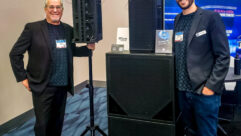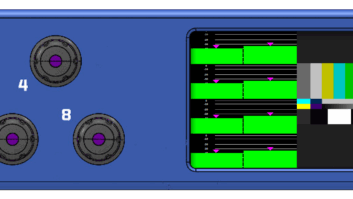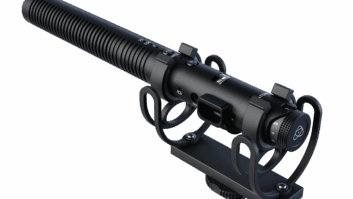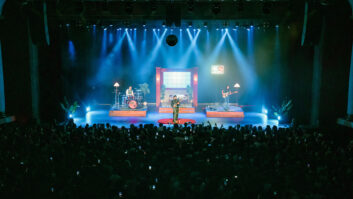
Technology Showcase:
Line Array Loudspeakers
Dec 1, 2005 12:00 PM,
By Daniel Keller
Established concept with a contemporary application.
Browsing most speaker manufacturers’ current offerings, it’s hard to imagine that as recently as a decade ago, line arrays were a relatively uncommon commodity in the world of live sound. Although the technology has been around for quite a while (described in Harry F. Olson’s “Acoustical Engineering” in 1957), only in the last few years has everyone and his mother seemingly jumped on the line-array bandwagon, with systems of all shapes and sizes hitting the market on a regular basis. (And, harkening back to those novelty miniature Marshall stacks, I’m waiting for a sub-miniature desktop line array compatible with my computer and iPod.)
QSC Audio’s ISIS WideLine
As with much of the evolution of audio and loudspeaker technology, the origin of the line array is somewhat uncertain. Early designs are often credited to audio pioneer Rudy Bozak, who introduced the concept of multiple drivers in a strictly linear configuration (the speaker columns popular in the late 1960s and 1970s, epitomized by Shure’s Vocal Master and systems by JBL, University, Altec, and others), designed for increased vertical dispersion. Dr. Christian Heil, creator of V-DOSC (Diffuser d’Onge Sonore Cylindrique — in English, Cylindrical Wave Generator) was among the first to market the concept of a line source to better reproduce a wider frequency range with improved directivity. Still, it’s only the recent evolution of sophisticated computer modeling technologies that has brought about large-scale implementation of line-array designs capable of a more musical application.
The basic concept of the contemporary line array in the familiar curved application is to create a set of speakers whose spacing and positioning allow greater. The lower boxes are directed downward to cover the forward rows of the audience, while the upper boxes can be aimed at the upper seating in an arena setting or at the floor of the rear seats in a ballroom-type environment.
Properly done, a good line array will distribute the overall SPL equally throughout each individual cabinet. Most individual line array cabinets do not offer a wide vertical coverage pattern — rarely greater than 10 degrees to 12 degrees — and the SPL at a particular coverage area is governed by the angles between adjacent cabinets. The top of an array will typically use several boxes with little or no angle between them, with the summed outputs resulting in a longer throw to the rear seats. Conversely, the lower portion of the array will gradually increase the angles between cabinets, increasing the SPL over a wider splay and reducing the levels accordingly. Thus, if configured correctly, a proper line array will distribute the SPL consistently in both levels and coverage pattern.
One of the main benefits of a focused line array is the ability to achieve longer throw with more consistent SPL and higher gain before feedback, while reducing reflected energy by directing the sound away from ceilings. A curvilinear array also reduces the lobe comb-filtering effect by making sure none of the adjacent speakers are horizontal to each other.
On the other hand, a poorly configured line array can defeat its purpose, creating inconsistent coverage over a large area. Too small an angle between cabinets can lead to hot spots that receive too much SPL, while splaying boxes too widely can create areas with inadequate coverage. In most cases of misconfigured line arrays, both maladies occur simultaneously, typically caused by a single maladjusted cabinet.
With this in mind, most manufacturers offer software applications to measure coverage and calculate how to hang their arrays. Most, however, are specific to their particular product.
Generally speaking, the longer the line array (i.e., the more cabinets flown) the better the pattern control. Increasing the size of the array helps to focus the sound away from unused areas and reflective surfaces, wasting less energy pumping air into places it doesn’t need to go. In most cases, there’s little point to flying fewer than six boxes.
What follows is an overview of most of the large-scale line array offerings currently available. It is not comprehensive, and, although we’ve tried to cover as many products as possible, it’s a technology whose offerings are in a state of flux. We apologize if we’ve left anyone out. While we’ve tried to focus on large-scale systems designed for concert sound and large installations, there are numerous smaller-scale line arrays from companies as diverse as Bose and TOA, among others. It’s also important to note that most of the listed manufacturers offer compatible sub-woofer modules to complement their line array systems.

Meyer Sound’s MILO
Adamson Pro Audio’s Y-Axis series includes the Y-18, featuring two 18in. Kevlar LF drivers and offering 100 degrees of horizontal coverage with what the company refers to as its “Co-Linear Drive Module” technology, said to produce a perfectly curved, iso-phase sound source of mid- and high-frequency energy.
Dutch-German firm Alcons Audio offers the L-series, which includes the dual 6in. LR14 and dual 8in. LR16, two models featuring ribbon HF drivers. Its Morpher lens waveguides offer coverage of up to 90 degrees on the LR16 and 120 degrees on the LR14. The company also offers the smaller Q-series of modular line-source array columns.
A-Line Acoustics features the AL10 and AL8 systems, with two 10in. or two 8in. drivers, respectively, and a 90-degree dispersion pattern. It also offers the AL10W, a wide-line version of the AL10 with 150 degrees of coverage. All three feature the company’s EZAL adjustable rigging system, which allows easy positioning of individual cabinets from 0 to 19 degrees.
The Apogee Sound division of Bogen Communications has created the ALA-series, available in either 60- or 90-degree horizontal dispersion patterns. The ALA-3 and ALA-5 are two-way systems featuring dual 10in. and 15in. LF drivers, respectively. Both units offer twin 2in. HF compression drivers. The larger ALA-9 is a three-way system with dual 15in. woofers, dual 10in. midrange drivers, and three 2in. tweeters.
Stuttgart, Germany-based d&b audiotechnik’s Q-series consists of three models and the Q-SUB subwoofer. All three passive two-way designs offer a pair of 10in. LF drivers and a 1.3in. HF compression driver. The Q1 features a 75°×15° dispersion pattern, while the Q7 offers a wider 75°×40° pattern. The Q10 covers an even wider 110°×40° dispersion pattern.
Spain’s D.A.S. Audio has unveiled the Aero series, a compact line array available in passive or self-powered models. The Aero 38 is a three-way active system with a pair of 12in. LF drivers, two more 10in. midrange drivers, and a single 1.5in. HF neodymium driver, offering 4000W of power. The Aero 48 employs a pair of 15in. LF drivers, two 8in. midrange drivers, and the same 1.5in. HF driver, delivering up to 4400W of power.
Duran Audio of the Netherlands offers the Axys Target system, a self-powered design featuring 32-bit floating point DSP and hot-swappable class AB modular amplifiers. The mid/high unit consists of two 1.4in. HF compression drivers and two 10in. drivers.
Loud Technologies’ EAW division offers the KF760 line array, as well as the smaller KF730 SLAM (Small Line Array Module). The KF760 features a passive three-way, horn-loaded design, with dual 12in. woofers, dual 10in. midrange drivers, and two 2in. tweeters. The KF761is similarly configured, but uses 8in. midrange drivers.
Electro-Voice is widely known for its X-Array series, consisting of a line of 10 models in a wide range configurations. The company also offers the X-Line series, billed as the next-generation of X-Array, as well as numerous variations, including the Xi-series for permanent installations and the XLc compact series.
JBL’s Vertec line is another mainstay of the touring circuit. The line consists of two self-powered models — the dual 15in. VT4882DP and dual 12in. VT4888DP — along with three passive models: the VT4887 compact, VT4888 midsize, and VT4889 full-size line array.
L-Acoustics’ V-DOSC is also a respected name in line array technology, featuring an active three-way design with two 15in. LF, four 7in. midrange, and two 1.4in. HF drivers. The company also offers the smaller dV-DOSC and ARCS active two-way designs, as well as the recently-unveiled Kudo, an active three-way system with two 12in. woofers, four 5in. mids, and a pair of 1in. tweeters.
MacPherson Audio of Skokie, Ill., has created the AXIA, a compact three-way biamp or triamp system available in install and road versions. The AXIA cabinet houses one 600Wrms 15in. LF driver, two 8in. twin-coil midrange drivers, and a single 2in. HF compression driver mounted on a 90°×55° slot-CD horn. The AXIA system can also be used individually as a standalone loudspeaker.
United Kingdom-based Martin Audio’s Wavefront series is widely known in installed-sound and touring circles. The Wavefront 8 series includes a wide range of high-performance systems in various sizes designed to seamlessly work together, including the W8L, W8LC, and W8LM three-way enclosures.
McCauley Sound offers a range of line array components under the full-size Monarc line, including the MLA6 three-way system with dual 15in. LF drivers, dual 10in. midranges, and dual 1.4in. HF drivers, and the MLA3, which has dual 12in. LF drivers, dual 8in. mids, and dual 1.4in. HF drivers. The company also manufactures the mid-sized M.Line and In.Line series line arrays.
Berkeley, Calif.-based Meyer Sound has long been one of the leading manufacturers of self-powered line arrays, with its M3D and M2D series. More recently, it has introduced the MILO, a four-way design featuring 12in. low and low-mid drivers and ribbon emulation manifolds for mid-high and very high frequencies. Also available are the MILO 60 and MILO 120, narrow- and expanded-coverage versions, respectively, and the newly introduced Mica compact series.
Paris-based Nexo is another mainstay of the line-array community. Its Geo system includes the T-series T4805 and T2815 tangent-array modules, as well as the compact S-series S805 and S830 modules. All models feature the company’s “coherent downfill capability” and “logarithmic-curvature” array assembly system.
Italian manufacturers Outline manufactures a unique system it has christened the Butterfly Line. The name is taken from the design of the Hi-Pack unit, which handles midrange and high-frequency content. Its patented system features the company’s Double Parabolic Reflective Wave Guide technology, designed to direct all high-frequency content in an identical path. The company’s website is a wealth of information on the theory and design of line-array technology.
Professional Audio Systems manufactures a wide range of loudspeaker and peripheral products, including the RS-2LA, a two-way, dual 15in. system with 2in. HF driver, and the 12.LA, a 12in. coaxial system. The company offers several package systems.
Costa Mesa, Calif.-based QSC Audio has an established reputation as one of the industry’s leading amplifier manufacturers, and the company’s recent foray into loudspeaker design has been highly successful. Its ISIS WideLine is a full-range wide-angle system with a 10in. long-throw driver, 140-degree horizontal dispersion pattern, and a three-way biamp or triamp design.
Renkus Heinz is another name long associated with loudspeaker design. The company offers the full-size STLA/9 and STXLA/9 powered and non-powered modules, respectively. Both feature dual 12in. woofers, dual 6.5in. midrange drivers, and a pair of 2.5in. HF voice-coil drivers, all with the company’s Isophasic Plane Wave design. Also available are the PN and PNX series, consisting of the PN102/LA and PNX102/LA, offering dual 10in. LF drivers and dual 1in. HF compression drivers.
SLS Pro Audio manufactures the RLA (Ribbon Line Array) series, including the RLA/1 three-way system with two 15in. LF drivers, four 6.5in. midrange speakers, and a pair of HF ribbon drivers. Also offered are the compact RLA/2 and RLA/3 two-way systems, with dual 8in. or 6.5in. woofers, respectively. Both also feature HF ribbon drivers.
Dutch firm Sound Projects features its Linex system, with dual 12in. woofers, four 6.5in. mids, and a pair of 1.5in. tweeters. Also available is the SP-series, ranging from the full-size SP30-Σ (with four 15in. woofers, four 8in. mids, and three 1.5in. tweeters) to the compact SP20-Σ and SP10-Σ, each with dual 12in. woofers, four 6.5in. midrange drivers, and a pair of 1.5in. tweeters.
Finally, TOA offers the SR-A series, a mid-sized array with single 12in. woofer. Featuring the company’s proprietary Synch-Drive horn technology, the system is available in short-throw (SR-A12S) and long-throw (SR-A12L) models.
For More Information
Adamson Pro Audio
www.adamsonproaudio.com
Alcons Audio
www.alconsaudio.com
A-Line Acoustics
www.a-lineacoustics.com
Apogee Sound
www.apogeesound.com
d&b audiotechnik
www.dbaudio.com
D.A.S. Audio
www.dasaudio.com
Duran Audio
www.duran-audio.com
EAW
www.eaw.com
Electro-Voice
www.electrovoice.com
L-Acoustics
www.l-acoustics.com
MacPherson Audio
www.macpherson-inc.com
Martin Audio
www.martin-audio.com
McCauley Sound
www.mccauleysound.com
Meyer Sound
www.meyersound.com
Nexo
www.nexo-sa.com
Outline
www.outline.it
Professional Audio Systems
www.pas-toc.com
QSC Audio
www.qscaudio.com
Renkus Heinz
www.renkus-heinz.com
SLS Pro Audio
www.slsloudspeakers.com
Sound Projects
www.soundprojects.com










